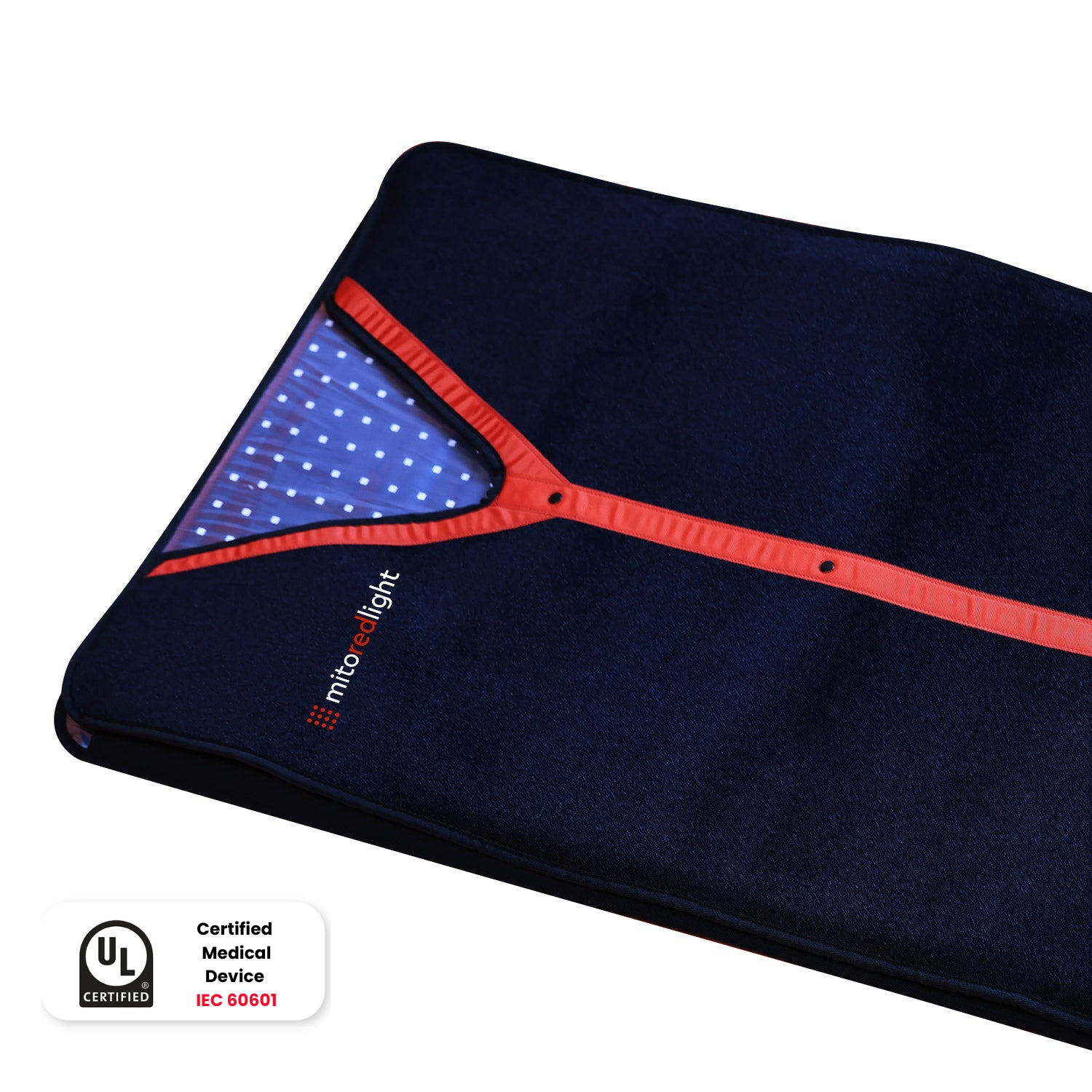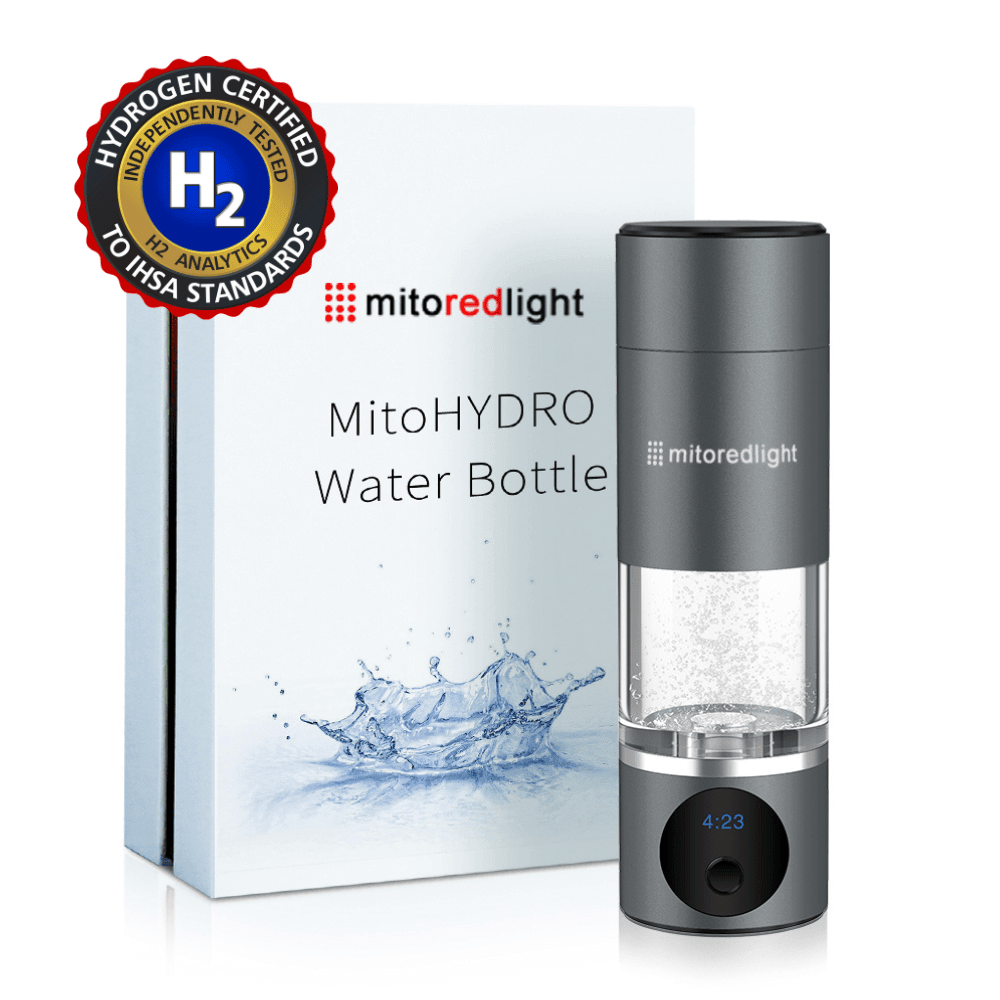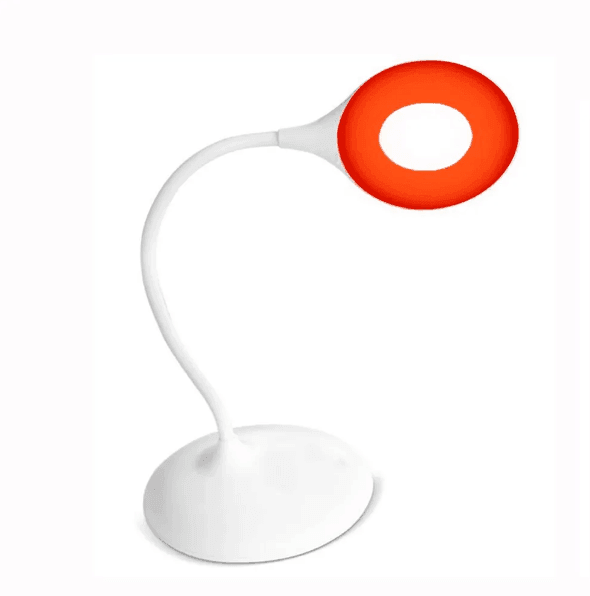DISCLAIMER: Mito Red Light devices are Class II wellness devices aimed at affecting the body through topical heating and supporting cellular function. The information provided in this article and on this site is for educational purposes only and is not intended to imply effectiveness of Mito Red Light devices for any specific application. The information provided in this article and on this site is not intended to diagnose, treat, cure, or prevent any disease, is not a substitute for consultation with a licensed medical provider and should not be construed as medical advice. Click here to read our article on potential contraindications of red light therapy..
Executive Summary
This Mito Red Light article explains how skin aging occurs due to collagen loss, slowed cell turnover, and oxidative stress. Red light therapy (RLT), using specific wavelengths of red and near-infrared light, stimulates cellular mitochondria to produce more energy, potentially combating these signs. RLT may boost collagen and elastin production, increase skin cell turnover, improve skin conditions like eczema and psoriasis, and enhance the skin's overall tone and texture. For anti-aging, consistent daily use (up to 20 minutes) with a red light panel is recommended. RLT is considered safe with no known side effects. Mito Red Light offers high-quality, third-party tested devices with optimal diode density for effective skin rejuvenation.
Key Takeaways:
- Skin aging involves collagen loss, slow cell turnover, and oxidative stress.
- Red light therapy stimulates cellular energy, potentially reversing aging signs.
- RLT may boost collagen and elastin, improving skin firmness and elasticity.
- Consistent daily use of red light therapy can enhance skin's appearance.
- Mito Red Light offers high-quality devices for effective at-home anti-aging RLT.
Medically Reviewed by | Heidi Wright, BSN, RN, PCCN
Let’s face it; the clock is continually moving forward, and the calendar years keep coming. While another year of life is definitely a blessing, the lines and wrinkles we develop may make us wish we could go back and take better care of our skin. Thankfully, there’s a solution for addressing the signs of aging that appear on our faces and bodies, and it doesn’t involve surgery or injections.
The team at Mito Red Light can’t give you a free pass to the Fountain of Youth, but they can give you access to a NASA-developed, scientifically proven therapy that helps restore and rejuvenate your skin in a non-invasive way. Curious? We thought so. We’ll introduce you to red light therapy, how it works, and how it can benefit your skin and even help improve skin’s resilience.
Before we get started, let’s look at how your skin functions and how it changes with age.
What Should You Know About Skin Aging?
The largest organ of your body has a massive job. Keeping your organs neatly tucked inside of you is one thing, but it also helps keep invasive bacteria, fungi, viruses, and other intrusive irritants on the outside.
The skin changes with time and exposure to the elements. These changes happen both internally and externally.
Loss of Collagen
Collagen is the protein that keeps your skin firm and plump. When we are young, collagen keeps our cheeks filled and gives us that iconic cherubic face we hated in grade school. With age, collagen production declines. This decline starts sooner than most of us expect, usually around age 20. We begin losing collagen at a rate of 1% per year in our 20s, which means by age 40, our collagen production has decreased each year by about 20%.
This collagen loss creates hollows under our eyes and in the shallows of our cheeks, allowing lines and wrinkles to form. It also causes the skin to feel and become thinner, which can lead to easier bruising, more visible blood vessels, and an overall uneven-looking skin tone.
Skin Cell Turnover
In addition to collagen loss, another skin function also slows. The skin is in a constant state of renewal. New skin cells are made in the deepest layers of the epidermis and are pushed up through the layers of your skin until they reach the surface. When they reach the surface, they eventually die and should be sloughed off naturally or through an exfoliation process (like scrubbing or using a chemical exfoliant).
Skin cell turnover happens rapidly when we are children, but the process slows down over time. With less new skin being created, discoloration, uneven skin texture, and scars have less chance to fade. In addition, dead skin cells can cling to the surface of the skin, causing it to look dull and unhealthy.
Oxidative Stress
The previous two occurrences happen due to changes within the skin as a result of simply existing, but oxidative stress is a two-fold problem. To fully understand it, you need to know a little about free radicals.
Free radicals are unbalanced molecules that damage healthy cells. This damage causes the cell to function improperly, or lose functionality completely. That damage can then be replicated in new cells upon proliferation.
“Free radicals are unstable molecules with unpaired electrons, making them like vandals looking to steal electrons from healthy skin cells. Think of free radicals like tiny invaders stealing your skin's youthful glow,” notes Heidi Wright, Registered Nurse.
Part of cellular respiration (the process that your cells use to create energy) produces reactive oxygen species, or ROS, which are free radicals. That means some free radical damage occurs naturally in the body.
Other free radicals are produced in response to external stressors like:
- Ultraviolet rays from the sun
- Pollution
- Dust and smog
- Cigarette smoke
- Some household and industrial cleaning supplies
The skin is continually being attacked by free radicals, and even though antioxidants offer protection from them, there’s no way to completely eliminate the possibility of this type of damage.
Bottom line: Your skin, as it ages, could use a little help. Although injectables and surgeries are definite options, many people simply want a non-invasive, holistic remedy that actually produces quantifiable results. For that, you want red light therapy.
What Is Red Light Therapy?
Light therapy has been used for centuries. We have texts that show it was used in ancient cultures as well as in medieval times. Now, we have access to newer and more powerful ways of harnessing this technology and understanding what it can do. Light therapy itself is called photobiomodulation. It involves the use of differing wavelengths of light to target health conditions and rejuvenate the body.
As a general rule, the shorter the wavelength of light, the less penetration it has on the body. Take, for instance, UV rays. They are short and ultra-high-energy. They interact with the epidermis, exciting the melanin in the skin and causing the skin to tan and eventually burn. It also reacts with cholesterol in the skin to produce vitamin D, which our bodies need to survive but cannot readily make on their own.
Different wavelengths of light can be used to target specific issues.
Red light therapy uses wavelengths of light that measure between 620 nanometers and 700 nanometers. These are much longer, lower energy wavelengths of light than ultraviolet rays, which are short and highly energetic. Near-infrared (NIR) light measures 800 nm to 900 nm and is able to penetrate the skin and reach both soft and hard tissue, like bone and muscle.
The use of red light was initially developed by NASA to help address wound healing with astronauts while they were in orbit. After decades of research, we now understand that wound healing is only a portion of what red light and NIR light can do.
How Does Red Light Therapy Work?
Before we unpack how red light therapy works to support the skin, it’s important to understand that red light is beneficial for virtually all tissues and organs in the body. The reason? It has to do with your cells. The cells of our bodies are the very building blocks that make us “us.” When our cells are healthy, we thrive.
Over time, however, cells begin to lose function. Experts studying longevity have identified 12 hallmarks of aging within our cells which they believe underlie the entire aging process. One of the hallmarks has to do with the loss of mitochondrial function. The mitochondria inside our cells are tiny organelles that are responsible for producing adenosine triphosphate, or “ATP.” ATP is cellular energy. Your cells’ other organelles need this important molecule to fuel their cellular processes.
When mitochondria become dysregulated (which happens naturally with age), they produce less ATP but more ROS — the natural free radical associated with cellular respiration. This is a bad combination that leaves our cells depleted and can even cause them to stop functioning altogether.
Red light works by stimulating the mitochondria in your cells to work more efficiently. Specifically, red light is absorbed by a molecule known as cytochrome C oxidase. This molecule plays an important role in how ATP is created, and by stimulating it, red light helps your mitochondria make more ATP. More ATP means more cellular energy, and more cellular energy means a better functioning system.
What Are the Potential Skin Benefits of Red Light Therapy?
If you guessed that red light therapy stimulates skin cells to help them work harder, you’re on the right path. There are numerous benefits of red light therapy for your skin.
Collagen and Elastin Production
In the skin, red light targets fibroblasts. These cells are responsible for the creation of collagen, and research shows that the stimulation of these cells by red light might help them produce more collagen. In addition, you’ll also produce more elastin, a key protein that helps with the elasticity and resilience of your skin.
The creation of more collagen and elastin can help restore your skin’s resilience, causing it to feel tighter, look more sculpted, and appear visibly more youthful. However, the skin benefits don’t stop at collagen and elastin production.
Skin Cell Turnover
Red light therapy has also been associated with an increase in skin cell turnover. When your skin cells have more ATP, they naturally function more efficiently, which means you can experience faster skin cell turnover and newer skin. This was the primary goal of the NASA development of research into red light, because red light can help with wound healing by speeding it up and helping the skin to heal faster.
Skin Conditions
If you’re dealing with a skin condition like eczema or psoriasis, red light therapy may be able to help. It's been beneficial in helping calm and lower irritation during flare-ups and help increase the time between them in patients who have these conditions. It’s always best to consult a licensed physician to see if RLT is a good fit for you and your specific circumstances.
Skin’s Overall Appearance
Although red light therapy works over time, you’ll notice results very quickly. Most users say they notice visible changes within days of use, with benefits multiplying over continued periods of use. The skin’s overall tone and texture begin to improve, and over time, the appearance of fine lines, wrinkles, and resilience also improves.
How To Use Red Light Therapy for Skin
It’s easy to focus solely on facial skin when we talk about skin aging, but most of us notice signs of skin aging on our bodies, too. For this reason, investing in a red light panel is the smartest way to treat different areas of your skin (including your face).
How Often Can I Use Red Light?
You can use red light therapy for up to 20 minutes per day, every day. Red light therapy is generally recognized as safe — however, there’s no research that shows you’ll get any more benefits by using red light therapy for longer periods of time, so it’s best to use it as instructed.
Is Red Light Therapy Safe?
Red light therapy is largely considered safe. There are currently no known side effects of using red light therapy. If you have skin sensitivity, be careful when using a red light therapy device that sits directly on your skin. If you experience any type of irritation, discontinue use and speak to your healthcare professional.
Red light is not damaging to your eyes, but if you have sensitive eyes, you can opt to wear red light protective eyewear to reduce any discomfort you might experience.
Where Can I Get Red Light Treatment?
You can find red light therapy available at medspas and dermatologist offices, but since repeated exposure to red light therapy is key, investing in an at-home red light therapy device can save you time and money and allow you to use red light on other areas of your body for other benefits.
Why Mito Red Light?
When it’s time to shop for a red light therapy device, Mito Red Light gives you access to the highest quality products that are effective, researched, and third-party tested.
Our Lights
Our lights are formatted with more diodes per square inch than our competitors, and that’s important. When a panel only contains a limited number of diodes, there can be dead space that does not allow for the maximum treatment. All of our devices and panels have the most diodes possible for maximum treatment and exposure.
Our Testing
We third-party test our lights to ensure they all have the specific wavelengths of light we say they do and are well within the therapeutic window of red light therapy treatment as defined by science.
Accessibility
No matter what your needs may be, we’ve got a device that will fit your space and budget and allow you to meet your therapy goals.
Advanced Technology
Our devices are specially formatted with Enhanced Spectral Energy Output™, a technology that delivers energy across all spectrums of red and NIR light.
Our MitoPRO series offers multi-wavelengths that give you access to even more spectrums of red and NIR light and contains an even split of the four peak action spectra LEDs for even coverage. This technology is only available with Mito Red Light and sets us apart from our competitors.
Give Your Skin the Red Treatment
Rejuvenating your skin doesn't have to involve invasive measures. You can get real results with red light therapy, a scientifically-backed therapy that targets your skin at the cellular level and helps improve your skin by supporting the body’s cellular function.
Sources:
https://training.seer.cancer.gov/melanoma/anatomy/layers.html|Seer.Cancer.gov
Free radicals and extrinsic skin aging|PubMed
Transcranial near-infrared light in treatment of neurodegenerative diseases|Frontiersin.org
NASA Research Illuminates Medical Uses of Light | NASA.gov
Hallmarks of aging: An expanding universe|PubMed
Low-level laser (light) therapy (LLLT) in skin: stimulating, healing, restoring - PMC

























